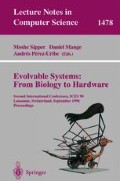Abstract
Evolvable Hardware (EHW) has been proposed as a new method for designing systems for complex real world applications. One of the problems has been that only small systems have been evolvable. This paper indicates some of the aspects in biological systems that are important for evolving complex systems. Further, a divide-and-conquer scheme is proposed, where a system is evolved by evolving smaller subsystems. Experiments show that the number of generations required for evolution by the new method can be substantially reduced compared to evolving a system directly. However, there is no lack of performance in the final system.
Preview
Unable to display preview. Download preview PDF.
References
M. Iwata et al. A pattern recognition system using evolvable hardware. In Proc. of Parallel Problem Solving from Nature IV (PPSN IV). Springer Verlag, LNCS 1141, September 1996.
M. Murakawa et al. Hardware evolution at function level. In Proc. of Parallel Problem Solving from Nature IV (PPSNIV). Springer Verlag, LNCS 1141, September 1996.
J. R. Koza. Genetic Programming II: Automatic Discovery of Reusable Programs. The MIT Press, 1994.
M. Salami et al. Lossless image compression by evolvable hardware. In Proc. of 4th European Conf. on Artificial Life (ECAL97). MIT Press, 1997.
W. Liu et al. Atm cell scheduling by function level evolvable hardware. In T. Higuchi et al., editors, Evolvable Systems: From Biology to Hardware. First Int. Conf., ICES 96, pages 180–192. Springer-Verlag, 1997. Lecture Notes in Computer Science, vol. 1259.
M. Murakawa et al. Evolvable hardware for generalized neural networks. In Proc. of Fifteenth Int. Joint Conf. on AI (IJCAI-97). Morgan Kaufmann Publishers, 1997.
J. Torresen. Evolvable hardware — A short introduction. In Proc. of International Conference On Neural Information Processing (ICONIP’97, Dunedin, New Zealand). Springer-Verlag, November 1997.
J. Torresen. Evolvable hardware — The coming hardware design method? In N. Kasabov and R. Kozma, editors, Neuro-fuzzy tools and techniques for Information Processing. Physica-Verlag (Springer-Verlag), 1998. To appear.
M. Sipper et al. A phylogenetic, ontogenetic, and epigenetic view of bio-inspired hardware systems. IEEE Trans. on Evolutionary Computation, 1(1):83–97, April 1997.
X. Yao and Y. Liu. Evolutionary artificial neural networks that learn and generalize well. In Proc. of IEEE Int. Conf. on Neural Networks, Washington DC. IEEE Press, 1996.
X. Yao and T. Higuchi. Promises and challenges of evolvable hardware. In T. Higuchi et al., editors, Evolvable Systems: From Biology to Hardware. First Int. Conf., ICES 96. Springer-Verlag, 1997. Lecture Notes in Computer Science, vol. 1259.
T. Higuchi et al. Evolvable hardware and its applications to pattern recognition and fault-tolerant systems. In E. Sanchez and M. Tomassini, editors, Towards Evolvable Hardware: The evolutionary Engineering Approach. Springer-Verlag, 1996. Lecture Notes in Computer Science, vol. 1062.
P. Marchal et al. Embryological development on silicon. In R. Brooks and P. Maes, editors, Artificial Life IV, pages 371–376. MIT Press, 1994.
A. Thompson. An evolved circuit, intrinsic in silicon, entwined with physics. In T. Higuchi et al., editors, Evolvable Systems: From Biology to Hardware. First Int. Conf., ICES 96. Springer-Verlag, 1997. Lecture Notes in Computer Science, vol. 1259.
M. Sipper. Evolution of Parallel Cellular Machines: The Cellular Programming Approach. Springer-Verlag, 1997. Lecture Notes in Computer Science, vol. 1194.
Author information
Authors and Affiliations
Editor information
Rights and permissions
Copyright information
© 1998 Springer-Verlag Berlin Heidelberg
About this paper
Cite this paper
Torresen, J. (1998). A divide-and-conquer approach to Evolvable Hardware. In: Sipper, M., Mange, D., Pérez-Uribe, A. (eds) Evolvable Systems: From Biology to Hardware. ICES 1998. Lecture Notes in Computer Science, vol 1478. Springer, Berlin, Heidelberg. https://doi.org/10.1007/BFb0057607
Download citation
DOI: https://doi.org/10.1007/BFb0057607
Published:
Publisher Name: Springer, Berlin, Heidelberg
Print ISBN: 978-3-540-64954-0
Online ISBN: 978-3-540-49916-9
eBook Packages: Springer Book Archive

